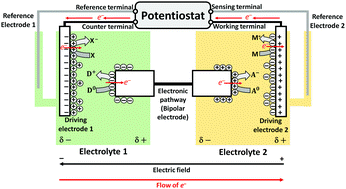Closed bipolar electrochemistry in a four-electrode configuration
Abstract
Closed bipolar electrochemistry in a 4-electrode configuration is a highly versatile, but under-utilized, technique with major potential to emerge as a powerful methodology impacting areas as diverse as spectro-electroanalysis, energy storage, electrocatalysis and electrodeposition. In this perspective, we provide the thermodynamic framework for understanding all such future applications of closed bipolar electrochemistry in a 4-electrode configuration. We distinguish the differences between open and closed bipolar electrochemical cells. In particular, the use of the 4-electrode configuration in both open and closed bipolar electrochemical cells with immiscible aqueous–organic solutions is outlined. A comprehensive overview of the influence of external bias on the thermodynamics underpinning electron transfer from an organic redox couple to an aqueous redox couple, or vice versa, by electrons flowing along a conducting bipolar electrode serving as an electronic bridge is provided. Fermi level equilibration between redox species at opposite poles of a bipolar electrode under external bias is discussed. The concept of the Line of Zero Overpotential (LZO) on the bipolar electrode at steady-state conditions under an external bias is introduced. The influence of a series of experimental variables (redox potential of each redox couple, rate constant of electron transfer at each pole, an excess bulk concentration of one redox couple over the other, and areas of the poles of the bipolar electrode in contact with each electrolyte solution) on the final position of the LZO on the bipolar electrode is highlighted. A cyclic voltammogram obtained using a closed bipolar electrochemical cell in a 4-electrode configuration with immiscible aqueous–organic electrolyte solutions is explained using the thermodynamic theory detailed throughout the perspective. The theory presented herein is equally applicable to a closed bipolar electrochemical cell in a 4-electrode configuration with aqueous electrolyte solutions, each containing redox active species, in both compartments connected by a bipolar electrode.



 Please wait while we load your content...
Please wait while we load your content...